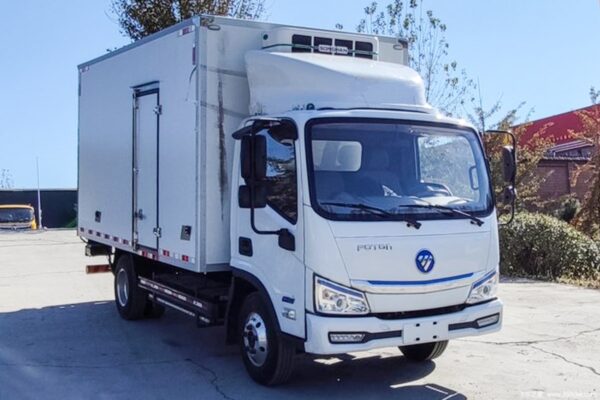ელექტრო სატვირთო მანქანების ცოდნა
Performance Testing Methods for Power Battery Thermal Management Systems
1. Scope
This standard specifies the test methods for evaluating the performance of thermal management systems in power batteries. It includes test conditions, test procedures, performance evaluation criteria, and reporting requirements. This standard applies to thermal management systems for power batteries used in electric vehicles (EVs), hybrid electric vehicles (HEVs), and other relevant applications.

The following documents are essential for the application of this standard. For dated references, only the specified edition applies. For undated references, the latest edition, including amendments, applies.
- GB/T 18384.1 Electric Vehicles – Safety Specifications
- GB/T 31467 Lithium-ion Batteries for Electric Vehicles
- GB/T 31486 Test Methods for Lithium-ion Battery Systems Used in Electric Vehicles
- GB/T 32056 Test Methods for Thermal Management Systems of Lithium-ion Batteries
3. Terms and Definitions
3.1 Power Battery Thermal Management System (TMS): A system that regulates the temperature of a power battery to ensure optimal operating conditions and safety.
3.2 Thermal Runaway: A self-accelerating, uncontrolled increase in battery temperature leading to potential safety hazards.
3.3 Cooling Efficiency: The system’s ability to remove excess heat from the battery pack within a specific timeframe.
3.4 Heating Performance: The system’s capability to raise battery temperature under cold conditions to ensure optimal performance.
3.5 Energy Consumption of TMS: The amount of energy consumed by the thermal management system during operation.
4.1 Ambient Conditions
- Temperature: (23 ± 2) °C unless otherwise specified
- Relative humidity: 30%–80%
- Atmospheric pressure: 86–106 kPa
4.2 Battery Conditions
- The battery should be in a fully operational state without defects.
- Preconditioning: Before testing, the battery should be charged to 100% SOC (State of Charge) and kept at rest for at least 12 hours.
4.3 Thermal Management System Conditions
- The TMS should be installed as per the manufacturer’s specifications.
- The cooling and heating systems should be fully operational.
- Coolant and refrigerants must be within manufacturer-specified levels.

5. Test Methods
5.1 Cooling Performance Test
5.1.1 Purpose To evaluate the system’s ability to dissipate heat and maintain battery temperature within optimal limits.
5.1.2 Procedure
- Step 1: Preheat the battery pack to (50 ± 2) °C.
- Step 2: Activate the thermal management system in cooling mode.
- Step 3: Measure the temperature reduction over a specified period.
- Step 4: Record power consumption, coolant flow rate, and temperature differentials.
- Step 5: Evaluate efficiency using the formula:
where is the heat removed and is the energy consumed by the system.
5.2 Heating Performance Test
5.2.1 Purpose To determine the system’s ability to increase battery temperature in cold conditions.
5.2.2 Procedure
- Step 1: Cool the battery pack to (-20 ± 2) °C.
- Step 2: Activate the thermal management system in heating mode.
- Step 3: Measure the temperature increase over time.
- Step 4: Record power consumption and heating efficiency.
- Step 5: Evaluate heating efficiency using the formula:
where is the heat supplied and is the energy consumed.
5.3 Uniformity Test
5.3.1 Purpose To assess the ability of the TMS to maintain a uniform temperature across the battery pack.
5.3.2 Procedure
- Step 1: Install thermocouples at multiple points on the battery pack.
- Step 2: Operate the system under normal charging and discharging cycles.
- Step 3: Record temperature variations across all measurement points.
- Step 4: Analyze data to determine uniformity using statistical deviation metrics.
5.4 Energy Consumption Test
5.4.1 Purpose To measure the energy required to operate the thermal management system under normal conditions.
5.4.2 Procedure
- Step 1: Operate the system for a fixed duration.
- Step 2: Record total energy consumption.
- Step 3: Calculate the energy consumption rate per unit of heat removed or added.
5.5 Failure Response Test
5.5.1 Purpose To assess system performance under fault conditions such as sensor failure, coolant leakage, or system shutdown.
5.5.2 Procedure
- Step 1: Introduce a controlled fault (e.g., disable a cooling fan).
- Step 2: Monitor system response and temperature variations.
- Step 3: Record data and evaluate safety mechanisms.

6. Performance Evaluation Criteria
6.1 Cooling and Heating Efficiency
- Cooling efficiency should be greater than 70%.
- Heating efficiency should be greater than 65%.
6.2 Temperature Uniformity
- The maximum temperature difference across the battery pack should not exceed 5°C under normal operating conditions.
6.3 Energy Consumption
- The system should consume less than 5% of total battery capacity per hour of operation.
6.4 Safety Compliance
- No thermal runaway events should occur under normal or fault conditions.
- The system should automatically shut down in case of a major failure.
7. Test Report
The test report should include:
- Description of the tested system
- Test conditions and parameters
- Measurement data and analysis
- Performance evaluations
- Conclusions and recommendations

8. დასკვნა The thermal management system plays a critical role in ensuring the safety, longevity, and performance of power batteries in electric vehicles. By following the testing methods outlined in this standard, manufacturers can ensure their systems meet industry benchmarks, improving efficiency and reliability in real-world applications.
